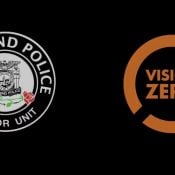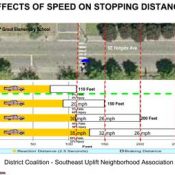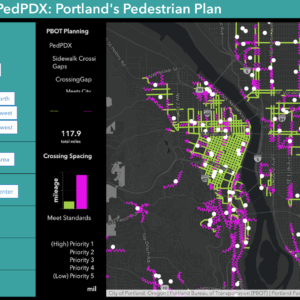“Speed kills” is such a well-known mantra in transportation advocacy circles it’s at risk of becoming trite. So how can activists find new ways to communicate the crucial linkage between speeding drivers and the fatal crashes they cause?
One answer to that question comes from a project by Portland Community College Student Jake Veto. Veto partnered with nonprofit group Oregon Walks to create an interactive map that illustrates pedestrian fatalities in Portland between 2017 and 2020. The 48 locations where people where struck and killed are marked on the map alongside colored street segments. The darker red the color, the higher percentage of speeding on that particular street segment.
The combination of speed data to street segments, combined with the location of the fatality, gives us a new context to understand why people on foot are more likely to be killed in certain places. Veto’s map also allows viewers to click on any marked segment and see the the posted speed limit and the percentage of drivers who disobey it.



The map uses crash data from the Oregon Department of Transportation and speed monitoring data from the Portland Bureau of Transportation.
One speeding hotspot with two “x” marks for deaths is SE Division between SE 122nd and 145th, where PBOT data shows people drive over the speed limit at a shocking rate of 75% to 83% of the time. The dark red intersection of SW Capitol Hwy and SW Terwilliger reveals that 95.5% of drivers speed through that location (according to 2021 data). I’ll remember that next time in biking or walking through. Yikes! (Note: It’s important to keep in mind that the speed monitoring data is often several years old, so it’s likely that speeds are lower today than what the map shows, since PBOT and other agencies redesign and update several roadways each year.)
Here’s an excerpt from Veto’s writeup of his methodology:
ODOT crash points were filtered to identify pedestrian fatalities within the Portland urban area. A case number field was added to the crash points attribute table for better identification. Manual matching of crash points to police reports was performed using date and cross streets to ensure accuracy. Each matched record was updated with its corresponding case number, and matched points were exported as a new dataset.
Finally, the data from the street sections that each crash was on was joined to the data from the crash points. This allows us to make statements about how often drivers tend to speed near where these crashes occured. Manual validation was performed on the points to make sure they were pulling data from the correct street segment. Many of the fatalities occured in intersections with different data for each of the cross streets, so best judgement and cross reference with the police reports was used to make sure that each point was correctly associated with the right street.
In addition to all the speed and fatality location data in the main map, Veto also created a general pedestrian fatality heat map. This map helps visualize which parts of the city’s road network people are most at risk of being hit and killed.
Veto’s work has illuminated what could be considered red zones for pedestrian safety. It should be a useful resource for planners, engineers, advocates, and anyone else who spends time on foot on Portland streets.
See the full map here.







Thanks for reading.
BikePortland has served this community with independent community journalism since 2005. We rely on subscriptions from readers like you to survive. Your financial support is vital in keeping this valuable resource alive and well.
Please subscribe today to strengthen and expand our work.
Fascinating Captain. It seems that Portland’s speeding culture was thriving at least 12 years ago, still was apparently on August 8th 2022 when 75% of drivers were speeding over the limit on Naito next to “Better Naito”.
They recently raised the speed limit next to Better Naito. Problem solved!
When did they raise the speed limit on Naito? I thought it was lowered for or after the completion of the recent work on Naito?
Looks great! I probably would have just graphed 85 percentile speeds though.
Yes, great as this map is, it left me wanting more. I’d like more percentages (like what percentage is over the speed limit, what percentage is more than 20% over, etc.) and then being able to refresh the map to show those.
Seeing all the red makes a strong statement about speeding, but on the other hand, with so much red, streets where people drive just over the speed limit look the same as streets where people drive dramatically faster. I’d like to see at a glance on the map which streets are the very worst.
And of course also seeing more streets covered, especially entire lengths of major streets.
Keep in mind that those streets not in color don’t mean no-one is speeding on them – it means PBOT has not measured speeds on them. Everyone should flood PBOT with requests to measure the traffic on their streets to complete the picture.
This is particularly evident on major Southwest streets like Patton, Humphrey, or similar. I can almost guarantee you that 95% of drivers there are speeding around blind corners on these sidewalkless and shoulderless streets, but they’re not picked up because PBOT can’t be bothered to care about this part of town.
Good point. Perhaps the streets with ‘no data’ could be made a colour not on the scale, like white lines?
Yeah, just got a car & driving it home the 1st time, I noticed the speed limit is 25. … prior while I’d wait for the bus I would have sworn it was atleast 35 or 40 based on the cars going by… On this map set, the street is blank…
Thank you, to Jason Veto!
Great map to poke around. Definitely confirms a lot of the things that I’ve experienced riding around. Gladstone/41st/42nd could be such a good bike route (it follows an old streetcar route after all), but the design just isn’t very comfortable imo (despite there being really obvious parallel routes for cars in Powell/Holgate and Cesar Chavez). It should be a candidate for “Ankeny-ification” and diverters.
I also used to ride home from work via Pomona/Arnold – a route marked as a bike route on the city bike map (though only as a shared roadway). Heading downhill on Arnold, drivers would pass me around blind corners at 40 mph (despite the fact that I was usually exceeding the speed limit). No surprise to see 90%+ of drivers exceeding the speed limit there.
And man, Terwillger should be one of the premier bike routes in the city. It’s a beautiful ride and the roadway is definitely wide enough for real bike infrastructure. But instead we have a wide road where 85% of drivers exceed the posted speed limit. Just a huge miss.
Pepperidge farm remembers when a BikePortland oped chided people who bike Terwilliger for not hardening the f*** up and riding near speeding drivers in a narrow and faded bike lane.
This was over on a Portland Reddit, from “aggieotis ” and is succinct – my emphasis on last line
Thank you Jake Veto and Oregon Walks for this informative map. Could outdated speed data be indicated somehow, e.g. color or dashed line? There are quite a few streets that have 8 – 10 year old data as PBOT doesn’t regularly monitor – only when requested.
It sure would be nice to have periodic monitoring like Washington County. https://www.washingtoncountyor.gov/traffic-road-engineering/traffic-counts
Thanks for an excellent story. Could the researcher provide more information on how the speed data was created? My understanding is it included speed cameras and pneumatic sensors. Disaggregated mobile phone data is another potential source.
PBOT has this: https://gis-pdx.opendata.arcgis.com/datasets/PDX::traffic-speed-counts/explore?location=45.484836%2C-122.699517%2C15.00.
How did the researcher decide how to map it?